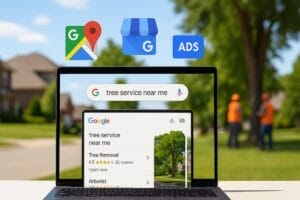Tree service companies face a big question in 2025: should you pay for leads or focus on generating leads organically? The truth is, both strategies can work but only if you understand what you’re paying for and how to get a solid return. This guide breaks down the costs, benefits, and best practices for purchasing tree service leads today.
The Changing Landscape of Tree Service Lead Generation
The way tree service companies attract customers has shifted dramatically. As homeowners rely more on online searches and lead platforms, it’s crucial to understand how modern lead generation works and where your business fits in. The following sections explain how customers find you, where paid leads originate, and why a balanced strategy works best.
How Homeowners Find Tree Services Today
Gone are the days when all your jobs came from referrals or newspaper ads. Today, customers search online using terms like “tree removal near me” or “emergency tree trimming in [city].” If your business doesn’t show up, you’re missing out.

Where Paid Leads Come From
Lead generation companies run digital ads and SEO campaigns to gather homeowner inquiries, then sell those leads to local tree service providers. Platforms like HomeAdvisor, Angi, and Thumbtack make it easy to tap into ready-to-quote leads, but competition and quality vary.
Smart Companies Use Both Paid and Organic Strategies
- Organic marketing builds trust and long-term visibility through SEO, Google reviews, and social media.
- Paid leads help fill your schedule quickly, especially in peak seasons or slow months.
What Tree Service Leads Really Cost in 2025
Not all leads are created equal and neither are their costs. Before investing in paid leads, it’s essential to understand the different pricing structures, potential hidden fees, and how conversion rates impact your true cost per customer. This section breaks down what you’re really paying for.

Types of Pricing Models
- Pay-per-lead: You pay for each inquiry, whether it turns into a job or not.
- Pay-per-call: You only pay when someone actually calls you (often more qualified).
- Subscription: A monthly fee gives you a certain number of leads or visibility.
Watch Out for Hidden Costs
Some lead platforms charge setup fees, monthly memberships, or take a commission on closed jobs. Premium leads or exclusive access can cost more, so make sure to factor everything in before signing up.
It’s Not Just About Price, It’s About Conversion
You might pay $50 for a lead, but if only 1 in 10 turns into a paying job, your real cost per customer is $500. Focus on lead quality and your ability to close jobs, not just the sticker price.
What Makes a Tree Service Lead “High Quality”
Paying for leads only pays off if those leads actually convert. But what makes a lead worth your time? In this section, we’ll explore the traits of a high-quality lead, compare organic vs. purchased lead performance, and highlight the key metrics to watch when evaluating lead quality.
Key Traits of a Good Lead
- Clear service need: tree removal, trimming, emergency work, etc.
- Located in your service area
- Reasonable timeline and budget
- Valid contact info and decision-making intent
Organic Leads vs. Purchased Leads
Leads who find you through your website or Google Business Profile often convert better, they were already searching for your specific service. Purchased leads might be shopping around or outside your target zone, so vet them carefully.
Metrics That Matter
- Contact rate: How many leads actually respond
- Appointment rate: How many book a quote or site visit
- Close rate: How many become paying customers
Pros and Cons of Buying Tree Service Leads in 2025
Like any marketing investment, paid leads come with upsides and trade-offs. Understanding both the advantages and disadvantages can help you decide when and how to use them effectively. Below, we outline the most important pros and cons to consider before spending your budget.
✅ Pros
- Quickly fill your calendar with booked jobs
- Set clear budget limits with pay-per-lead or call options
- Great for new businesses or expanding into new zip codes
❌ Cons
- Leads may be sold to multiple contractors (high competition)
- Quality varies, some leads are just price shoppers
- Over-reliance on lead providers can hurt long-term growth
Tip: Use paid leads as a supplement, not a replacement for your own marketing.
How to Maximize ROI From Purchased Leads
Getting leads is one thing, turning them into paying customers is another. To make paid leads worth the investment, you need a system that responds quickly, qualifies effectively, and tracks results. The tips below will help you boost conversion rates and increase your return on every dollar spent.
Respond Faster Than Your Competitors
The first contractor to call usually gets the job. Use text alerts, CRM tools, or lead notification apps to reply within minutes. Set up a system that ensures no lead goes cold.
Qualify Leads Quickly
Ask questions upfront: What service do they need? Where are they located? What’s the timeline? This helps weed out unqualified leads and focus your time where it counts.
Use Personalized Follow-Ups
- Send a quote via text or email
- Follow up with tips, reminders, or a limited-time offer
- Ask for a review after the job to boost your organic visibility
Track Your Results
Use call tracking or Google Analytics to measure conversion rates. Ask yourself:
- Which platforms give me the best ROI?
- What’s my average cost per booked job?
- Which zip codes or services convert best?
Pro Tip: Use these insights to negotiate better deals or adjust your targeting.
Final Thoughts: Is Paying for Leads Worth It?
Yes, if done right. Tree service companies that understand their numbers, respond fast, and focus on high-converting opportunities can see great returns from paid leads. But don’t stop there. Build your own website, collect reviews, post on Google, and create content that attracts organic leads too. A healthy mix of both gives you the strongest, most sustainable growth path.
Want help improving your lead quality or setting up your own marketing system? Reach out for a free consultation and see how we help tree service businesses grow in 2025.




